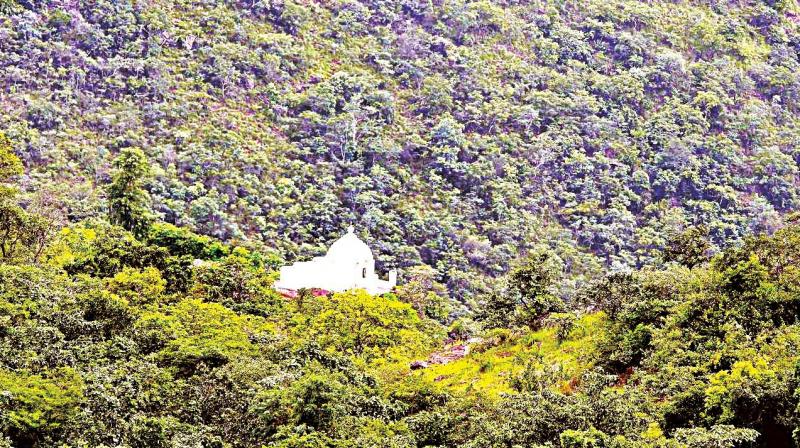Sunday Stroy: Kappatagudda Another bellary in the making

The state government declared the lush green Kappatagudda Hills, also rich in iron and gold ore deposits, a conservation reserve in 2015, making it clear that 89.92 hectares of forests are meant for preservation of their therapeutic plant species. But in a strange reversal, the Karnataka Wildlife Board headed by CM Siddaramaiah withdrew the conservation tag in November last, angering environmentalists and seers who accuse the government of giving in to the pressure from the mining lobby, Shivakumar Malagi focusses on the recent developments at Kappatagudda
Home to temples and religious maths, the lush green Kappatagudda hills of Gadag see people of around 40 surrounding villages make a beeline for their priests not just for divine blessings, but also for cures for all sorts of ailments, which they dole out in the form of the medicinal plants that grow in abundance here.
So deeply bonded are the people with the eco system that every religious ritual is in some way linked to the over 130 species of medicinal plants found in the hills. “The plants and holy water found in the Kappattagudda hills have the ability to boost immunity and healing. Many devotees have been cured of paralysis, asthma, blood pressure and diabetes after being treated with the plants and farmers believe that if they sprinkle the water on their farmland it will keep away pests and crop disease,” says head of Kappatteshwar temple Mallikarjun Swami.
For once, the state government responded positively to this way of life and declared the Kappatagudda hill range a conservation reserve on December 19, 2015, making it clear that 89.92 hectares of forests were meant for preservation of their therapeutic plants. But in a strange reversal, the Karnataka Wildlife Board headed by CM Siddaramaiah, withdraw this conservation tag by a November 4, 2016 notification, angering environmentalists and seers.
A ‘Save Kappatagudda’ campaign has since been launched by the seer of Gadag Tontadarya Math, Siddhalinga Swami and Annadaneshwara Mahashivayogi Math seer, Abhinava Annadaneshwara Swami, who accuse the government of acting under pressure from the mining lobby as the hills are also rich in iron and gold ore deposits. In fact, gold diggers have for years been searching for the precious metal in these hills.
During the rains, they place sieves in the way of the water coming down the hillsides to collect grains of the metal, which they then sell to local goldsmiths. Many do sub-surface mining wherever they strike gold veins and local traders still go to villages in Shirahatti taluk to buy gold stones.
The discovery of gold ore in and around Gadag is not a recent phenomenon, however. The early 20th century saw extensive exploration and development of Gadag gold field by Dharwad Gold Mines Ltd and M/s John Taylor and Sons of London worked for eight years (1902-1910) in the field. But the poor gold recovery from the reefs forced the mining companies to shut operations, and by 1912, mining was abandoned.
Now, Ramgad Minerals and Mining Pvt Ltd (RMMPL), a Baldota group company, has been granted mining rights in an open cast mine in Sangli village, 32 km from Gadag, setting off speculation about the government’s intentions in withdrawing the conservation tag for the hills.
A company officer reveals that the company has been permitted to set up a 1,000-tonne per day (TPD) gold ore processing plant in Gadag district. “The plant is being set up in collaboration with a South African company, Turnberry. It will come up at Attikatti with an initial investment of '300 crore. We are planning to start operations in Sangli,” he adds.
The Sangli mine is estimated to contain 2.4 million tonnes of gold ore and each tonne is expected to yield 2.8 grams of gold. At this rate, the company could produce 8,000 kg of gold from this mine alone, according to sources.
But company officials say there will be no mining in the Kappatgudda range. “We have been permitted to mine near Jelligeri reserve forest, 30 km from the hills and some distance from the Tungabhadra. In fact, three environmental surveys have been done covering a buffer zone of 10 km surrounding the mining area and processing plant and reports have been submitted to MoEF for clearance. After all, this is not a factory. There will be no smoke and the amount of dust will be minimal which will be managed by sprinkling water,” adds an officer.
The government denies it has withdrawn the conservation tag under pressure from mining lobby and claims it has merely responded to opposition from the villagers as it comes in the way of grazing their cattle in the forests here. But former GP president Shankargouda says the villagers have no objection to the conservation tag for the hill range if their interests are protected.
“The government should cancel the lease for a wind power project and prevent gold mining in the hills. Also, it should not evacuate us from the forests. We will ourselves protect the hills if the forest officials stop harassing us,” he says.

